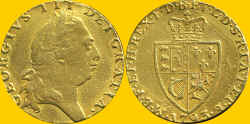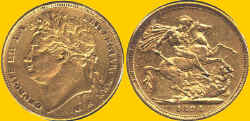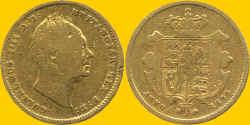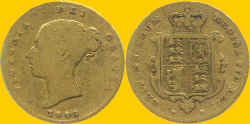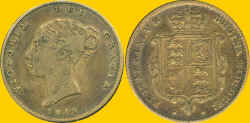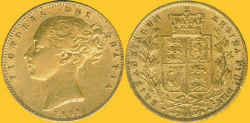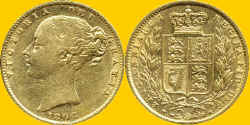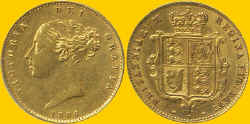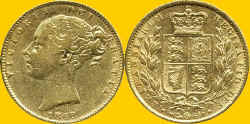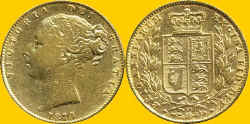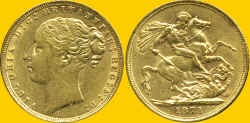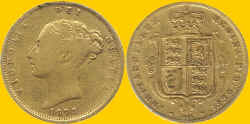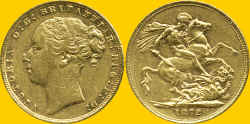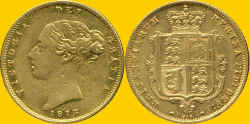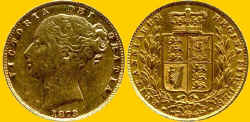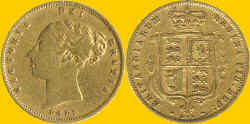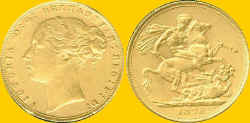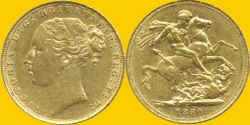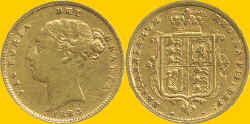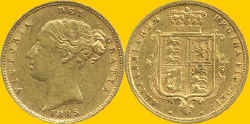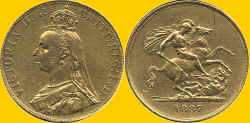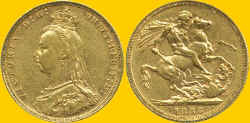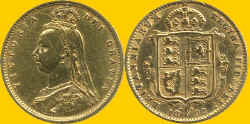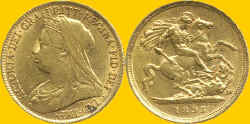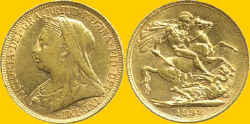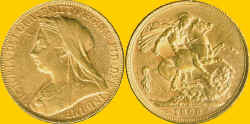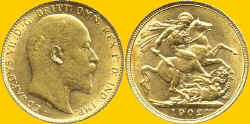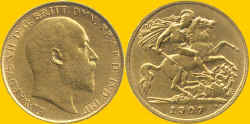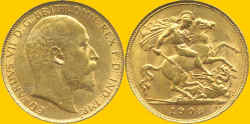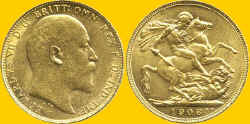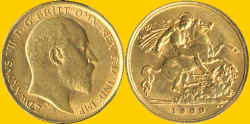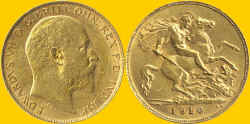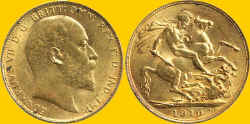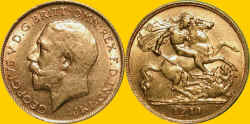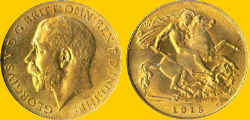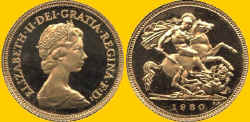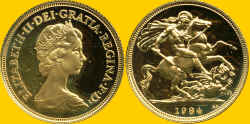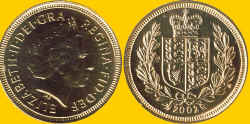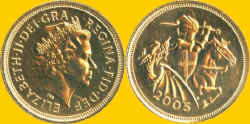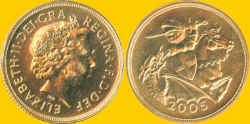This is the Worldwide Numismatics Website!
This is a modest collection of second millennium gold coins of Great Britain from the late 1700s into the 20th Century
Click the thumbnail picture to see a larger version of the picture, then use your browser BACK button to return to the original page you were viewing.
1 Guinea - 1793
KM-609 -
8,35 g
The obverse features a bust of King George III (b1738-d1820). GEORGIVS III DEI GRATIA: (George III by Grace of God) surrounds the bust. The reverse has the crowned arms surrounded by the Latin legend M-B-F-ET-H-REX-F-D-B-ET-L-D-S- R-I-A-T-ET-E. The date 1793 is below the base of the arms.
1/2 Guinea - 1798
KM-608 -
4,18 g
The obverse features a bust of King George III (b1738-d1820). GEORGIVS III DEI GRATIA: (George III by Grace of God) surrounds the bust. The reverse has the crowned arms surrounded by the Latin legend M-B-F-ET-H-REX-F-D-B-ET-L-D-S- R-I-A-T-ET-E. The date 1798 is below the base of the arms.
1/3 Guinea - 1804
KM-650 - 2,78 g
The obverse features a bust of King George III (b1738-d1820). GEORGIVS III DEI GRATIA: (George III by Grace of God) surrounds the bust. The reverse has a crown surrounded by the Latin legend BRITTANIRVM REX FIDEI DEFENSOR (British King, Defender of the Faith). The date 1804 is below the base of the crown.
£½ - 1817
KM-673 - 3,99 g - 19,7 mm
Edge - Reeded
Mintage
- 2,080M
The obverse features a bust of King George III (b1738-d1820). GEORGIVS III DEI GRATIA: (George III by Grace of God) surrounds the bust. The reverse has a crowned shield surrounded by the Latin legend BRITTANIRVM REX FIDEI DEF (British King, Defender of the Faith). The date 1817 is below the base of the crown.
1 Sovereign - 1824
KM-682 - 7,99 g - 22 mm
Edge - Reeded
Mintage - 3,768M
The obverse features a bust of King George IV (b1762-d1830). GEORGIUS IIII D:G: BRITTANIAR:REX:F:D: (George IV by Grace of God, British King, Defender of the Faith) surrounds the bust. The initials E.P. and below the bust. The reverse has St. George slaying the dragon. The date 1824 is at the bottom with the designer's initials E.P. to to the top right.
1 Sovereign - 1826
KM-696 - 7,99 g - 22,1 mm
Edge - Reeded
The obverse features a bust of King George IV (b1762-d1830). GEORGIUS IV DEI GRATIA (George IV by Grace of God) surrounds the bust. The date 1826 isbelow the bust. The reverse has the Royal arms surrounded by the Latin legend BRITTANIARUM REX F:D: (British King, Defender of the Faith).
½ Sovereign - 1835
KM-722 - 3,99 g - 19,3 mm
Fineness - 0,917 Au/0,083 Cu
Mintage - 0,773M
Edge - Reeded
The obverse features a bust of King William IV (b1765-d1837). GULIELMUS IIII D:G: BRITTANIAR:REX F:D: (William IIII by Grace of God King of the Britons Defenderof the Faith) surrounds the bust. The reverse has the the Ensigns Armorial of the United Kingdom contained in a plain shield, surmounted by the Royal Crown, in the centre a smaller shield containing the arms of Hannover with the date ANNO 1835. The obverse was designed by William W. Wyon and the reverse by J. B. Merlen.
½ Sovereign - 1842
KM-735.1 - 3,99 g - 19,3 mm
Fineness - 0,917 Au/0,083 Cu
Mintage - 2,223M
Edge - Reeded
The obverse features a young bust of Queen Victoria (b1819-d1901). VICTORIA DEI GRATIA (Victoria by Grace of God) surrounds the bust with the date 1842 at the bottom. The reverse has the the Ensigns Armorial of the United Kingdom contained in a plain shield, surmounted by the Royal Crown and encircled with a laurel wreath, with the inscription BRITANNIARUM REGINA FID DEF , (British Queen, Defender of the Faith) having the united rose, thistle and shamrock placed under the shield. The obverse was designed by William W. Wyon and the reverse by J. B. Merlen.
½ Sovereign - 1846
KM-735.1 - 3,99 g - 19,3 mm
Fineness - 0,917 Au/0,083 Cu
Mintage - 1,064M
Edge - Reeded
The obverse features a young bust of Queen Victoria (b1819-d1901). VICTORIA DEI GRATIA (Victoria by Grace of God) surrounds the bust with the date 1846 at the bottom. The reverse has the the Ensigns Armorial of the United Kingdom contained in a plain shield, surmounted by the Royal Crown and encircled with a laurel wreath, with the inscription BRITANNIARUM REGINA FID DEF , (British Queen, Defender of the Faith) having the united rose, thistle and shamrock placed under the shield. The obverse was designed by William W. Wyon and the reverse by J. B. Merlen.
1 Sovereign - 1861
KM-736.1 - 7,99 g - 21,5 mm
Fineness - 0,917 Au/0,083 Cu
Mintage - 7,623M
Edge - Reeded
The obverse features a young bust of Queen Victoria (b1819-d1901). VICTORIA DEI GRATIA (Victoria by Grace of God) surrounds the bust with the date 1861 at the bottom. The reverse has the the Ensigns Armorial of the United Kingdom contained in a plain shield, surmounted by the Royal Crown and encircled with a laurel wreath, with the inscription BRITANNIARUM REGINA FID DEF , (British Queen, Defender of the Faith) having the united rose, thistle and shamrock placed under the shield. The obverse was designed by William W. Wyon and the reverse by J. B. Merlen.
1 Sovereign - 1862
KM-736.1 - 7,99 g - 21,5 mm
Fineness - 0,917 Au/0,083 Cu
Mintage - 7,836M
Edge - Reeded
The obverse features a young bust of Queen Victoria (b1819-d1901). VICTORIA DEI GRATIA (Victoria by Grace of God) surrounds the bust with the date 1862 at the bottom. The reverse has the the Ensigns Armorial of the United Kingdom contained in a plain shield, surmounted by the Royal Crown and encircled with a laurel wreath, with the inscription BRITANNIARUM REGINA FID DEF , (British Queen, Defender of the Faith) having the united rose, thistle and shamrock placed under the shield. The obverse was designed by William W. Wyon and the reverse by J. B. Merlen.
1
Sovereign - 1864
KM-736.2 - 7,99 g - 21,5 mm
Fineness - 0,917 Au/0,083 Cu
Mintage - 8,656M (all dies)
Edge - Reeded
The obverse features a young bust (of a young woman of 18 on her ascension to the throne) of Queen Victoria (b1819-d1901). VICTORIA DEI GRATIA (Victoria by Grace of God) surrounds the bust with the date 1864 at the bottom. The reverse has the the Ensigns Armorial of the United Kingdom contained in a plain shield, surmounted by the Royal Crown and encircled with a laurel wreath, with the inscription BRITANNIARUM REGINA FID DEF (British Queen, Defender of the Faith), having the united rose, thistle and shamrock placed under the shield. The obverse was designed by William W. Wyon and the reverse by J. B. Merlen. It is believed that most of the Shield reverse sovereigns were exported to India as the St. George reverse was unacceptable for religious grounds on the basis of idolatry. This was a special type that had the die number under the bow at the bottom. In this case, this was minted from Die. No. 97. Die numbers were on some sovereigns minted only from 1863 to 1884. The die numbers can be found on the reverse of the coins, beneath the wreath but above the rose near the bottom of the coin. There are many possible reasons for using die numbers. The most obvious is to be able to check and control the quality of the dies, particularly if experiments were being conducted into die wear. It is possible that different methods of treating and hardening dies may have been carried out, and die numbering would have helped to ascertain which methods of processing were most successful. Other possible reasons include quality and security control during production. This coin is particularly interesting because it has a "cud" from the rim through the "A" in Victoria (a "cud" is caused by a chipped die).
½
Sovereign - 1866
KM-735.2 - 3,99 g - 19,3 mm
Fineness - 0,917 Au/0,083 Cu
Mintage - 2,059M (all dies)
Edge - Reeded
The obverse features a young bust of Queen Victoria (b1819-d1901). VICTORIA DEI GRATIA (Victoria by Grace of God) surrounds the bust with the date 1866 at the bottom. The reverse has the the Ensigns Armorial of the United Kingdom contained in a plain shield, surmounted by the Royal Crown and encircled with a laurel wreath, with the inscription BRITANNIARUM REGINA FID DEF , (British Queen, Defender of the Faith) having the united rose, thistle and shamrock placed under the shield. The obverse was designed by William W. Wyon and the reverse by J. B. Merlen. This was a special type that had the die number under the bow at the bottom. In this case, this was minted from Die. No. 3. Die numbers were on some half sovereigns minted only from 1863 to 1880. The die numbers can be found on the reverse of the coins, beneath the wreath but above the rose near the bottom of the coin. There are many possible reasons for using die numbers. The most obvious is to be able to check and control the quality of the dies, particularly if experiments were being conducted into die wear. It is possible that different methods of treating and hardening dies may have been carried out, and die numbering would have helped to ascertain which methods of processing were most successful. Other possible reasons include quality and security control during production.
1
Sovereign - 1866
KM-736.2 - 7,99 g - 19,3 mm
Fineness - 0,917 Au/0,083 Cu
Mintage - 4,047M (all dies)
Edge - Reeded
The obverse features a young bust of Queen Victoria (b1819-d1901). VICTORIA DEI GRATIA (Victoria by Grace of God) surrounds the bust with the date 1866 at the bottom. The reverse has the the Ensigns Armorial of the United Kingdom contained in a plain shield, surmounted by the Royal Crown and encircled with a laurel wreath, with the inscription BRITANNIARUM REGINA FID DEF , (British Queen, Defender of the Faith) having the united rose, thistle and shamrock placed under the shield. The obverse was designed by William W. Wyon and the reverse by J. B. Merlen. It is believed that most of the Shield reverse sovereigns were exported to India as the St. George reverse was unacceptable for religious grounds on the basis of idolatry. This was a special type that had the die number under the bow at the bottom. In this case, this was minted from Die. No. 42. Die numbers were on some sovereigns minted only from 1863 to 1884. The die numbers can be found on the reverse of the coins, beneath the wreath but above the rose near the bottom of the coin. There are many possible reasons for using die numbers. The most obvious is to be able to check and control the quality of the dies, particularly if experiments were being conducted into die wear. It is possible that different methods of treating and hardening dies may have been carried out, and die numbering would have helped to ascertain which methods of processing were most successful. Other possible reasons include quality and security control during production.
1
Sovereign - 1868
KM-736.2 - 7,99 g - 19,3 mm
Fineness - 0,917 Au/0,083 Cu
Mintage - 1,653M (all dies)
Edge - Reeded
The obverse features a young bust of Queen Victoria (b1819-d1901). VICTORIA DEI GRATIA (Victoria by Grace of God) surrounds the bust with the date 1868 at the bottom. The reverse has the the Ensigns Armorial of the United Kingdom contained in a plain shield, surmounted by the Royal Crown and encircled with a laurel wreath, with the inscription BRITANNIARUM REGINA FID DEF , (British Queen, Defender of the Faith) having the united rose, thistle and shamrock placed under the shield. The obverse was designed by William W. Wyon and the reverse by J. B. Merlen. It is believed that most of the Shield reverse sovereigns were exported to India as the St. George reverse was unacceptable for religious grounds on the basis of idolatry. This was a special type that had the die number under the bow at the bottom. In this case, this was minted from Die. No. 39. Die numbers were on some sovereigns minted only from 1863 to 1884. The die numbers can be found on the reverse of the coins, beneath the wreath but above the rose near the bottom of the coin. There are many possible reasons for using die numbers. The most obvious is to be able to check and control the quality of the dies, particularly if experiments were being conducted into die wear. It is possible that different methods of treating and hardening dies may have been carried out, and die numbering would have helped to ascertain which methods of processing were most successful. Other possible reasons include quality and security control during production.
1
Sovereign - 1870
KM-736.2 - 7,99 g - 19,3 mm
Fineness - 0,917 Au/0,083 Cu
Mintage - 2,190M (all dies)
Edge - Reeded
The obverse features a young bust of Queen Victoria (b1819-d1901). VICTORIA DEI GRATIA (Victoria by Grace of God) surrounds the bust with the date 1870 at the bottom. The reverse has the the Ensigns Armorial of the United Kingdom contained in a plain shield, surmounted by the Royal Crown and encircled with a laurel wreath, with the inscription BRITANNIARUM REGINA FID DEF , (British Queen, Defender of the Faith) having the united rose, thistle and shamrock placed under the shield. The obverse was designed by William W. Wyon and the reverse by J. B. Merlen. It is believed that most of the Shield reverse sovereigns were exported to India as the St. George reverse was unacceptable for religious grounds on the basis of idolatry. This was a special type that had the die number under the bow at the bottom. In this case, this was minted from Die. No. 82. Die numbers were on some sovereigns minted only from 1863 to 1884. The die numbers can be found on the reverse of the coins, beneath the wreath but above the rose near the bottom of the coin. There are many possible reasons for using die numbers. The most obvious is to be able to check and control the quality of the dies, particularly if experiments were being conducted into die wear. It is possible that different methods of treating and hardening dies may have been carried out, and die numbering would have helped to ascertain which methods of processing were most successful. Other possible reasons include quality and security control during production.
1 Sovereign - 1871
KM-752 - 7,99 g - 21,5 mm
Fineness - 0,917 Au/0,083 Cu
Mintage - 8,767M (all dies incl all 1872)
Edge - Reeded
The obverse features a young bust of Queen Victoria (b1819-d1901). VICTORIA DEI GRATIA (Victoria by Grace of God) surrounds the bust with the date 1871 at the bottom. The reverse has the the Ensigns Armorial of the United Kingdom contained in a plain shield, surmounted by the Royal Crown and encircled with a laurel wreath, with the inscription BRITANNIARUM REGINA FID DEF , (British Queen, Defender of the Faith) having the united rose, thistle and shamrock placed under the shield. The obverse was designed by William W. Wyon and the reverse by J. B. Merlen.
½ Sovereign - 1872 Die No. 271
KM-735.2 - 3,99 g - 19,3 mm
Fineness - 0,917 Au/0,083 Cu
Mintage - 3,249M (all dies)
Edge - Reeded
The obverse features a young bust of Queen Victoria (b1819-d1901). VICTORIA DEI GRATIA (Victoria by Grace of God) surrounds the bust with the date 1872 at the bottom. The reverse has the the Ensigns Armorial of the United Kingdom contained in a plain shield, surmounted by the Royal Crown and encircled with a laurel wreath, with the inscription BRITANNIARUM REGINA FID DEF , ( British Queen, Defender of the Faith) having the united rose, thistle and shamrock placed under the shield. The plate number is located at the bottom center. The obverse was designed by William W. Wyon and the reverse by J. B. Merlen. This was a special type that had the die number under the bow at the bottom. In this case, this was minted from Die. No. 271. Die numbers were on some half sovereigns minted only from 1863 to 1884. The die numbers can be found on the reverse of the coins, beneath the shield near the bottom of the coin. There are many possible reasons for using die numbers. The most obvious is to be able to check and control the quality of the dies, particularly if experiments were being conducted into die wear. It is possible that different methods of treating and hardening dies may have been carried out, and die numbering would have helped to ascertain which methods of processing were most successful. Other possible reasons include quality and security control during production.
1 Sovereign - 1872
KM-752 - 7,99 g - 21,5 mm
Fineness - 0,917 Au/0,083 Cu
Mintage - 8,767M (all dies incl all 1871)
Edge - Reeded
The obverse features a young bust of Queen Victoria (b1819-d1901). VICTORIA DEI GRATIA (Victoria by Grace of God) surrounds the bust with the date 1871 at the bottom. The reverse has the the Ensigns Armorial of the United Kingdom contained in a plain shield, surmounted by the Royal Crown and encircled with a laurel wreath, with the inscription BRITANNIARUM REGINA FID DEF , (British Queen, Defender of the Faith) having the united rose, thistle and shamrock placed under the shield. The obverse was designed by William W. Wyon and the reverse by J. B. Merlen.
½ Sovereign - 1873 Die No. 305
KM-735.2 - 3,99 g - 19,3 mm
Fineness - 0,917 Au/0,083 Cu
Mintage - 3,249M (all dies)
Edge - Reeded
The obverse features a young bust of Queen Victoria (b1819-d1901). VICTORIA DEI GRATIA (Victoria by Grace of God) surrounds the bust with the date 1873 at the bottom. The reverse has the the Ensigns Armorial of the United Kingdom contained in a plain shield, surmounted by the Royal Crown and encircled with a laurel wreath, with the inscription BRITANNIARUM REGINA FID DEF , ( British Queen, Defender of the Faith) having the united rose, thistle and shamrock placed under the shield. The plate number is located at the bottom center. The obverse was designed by William W. Wyon and the reverse by J. B. Merlen. This was a special type that had the die number under the bow at the bottom. In this case, this was minted from Die. No. 305. Die numbers were on some half sovereigns minted only from 1863 to 1884. The die numbers can be found on the reverse of the coins, beneath the shield near the bottom of the coin. There are many possible reasons for using die numbers. The most obvious is to be able to check and control the quality of the dies, particularly if experiments were being conducted into die wear. It is possible that different methods of treating and hardening dies may have been carried out, and die numbering would have helped to ascertain which methods of processing were most successful. Other possible reasons include quality and security control during production.
1 Sovereign - 1873 Die No. 25
KM-736.2 - 7,99 g - 21,5 mm
Fineness - 0,917 Au/0,083 Cu
Mintage - 2,368M (all dies)
Edge - Reeded
The obverse features a young bust of Queen Victoria (b1819-d1901). VICTORIA DEI GRATIA (Victoria by Grace of God) surrounds the bust with the date 1873 at the bottom. The reverse has the the Ensigns Armorial of the United Kingdom contained in a plain shield, surmounted by the Royal Crown and encircled with a laurel wreath, with the inscription BRITANNIARUM REGINA FID DEF , ( British Queen, Defender of the Faith) having the united rose, thistle and shamrock placed under the shield. The obverse was designed by William W. Wyon and the reverse by J. B. Merlen. It is believed that most of the Shield reverse sovereigns were exported to India as the St. George reverse was unacceptable for religious grounds on the basis of idolatry. This was a special type that had the die number under the bow at the bottom. In this case, this was minted from Die. No. 25. Die numbers were on some sovereigns minted only from 1863 to 1884. The die numbers can be found on the reverse of the coins, beneath the wreath but above the rose near the bottom of the coin. There are many possible reasons for using die numbers. The most obvious is to be able to check and control the quality of the dies, particularly if experiments were being conducted into die wear. It is possible that different methods of treating and hardening dies may have been carried out, and die numbering would have helped to ascertain which methods of processing were most successful. Other possible reasons include quality and security control during production.
1 Sovereign - 1873 Die No. 42
KM-736.2 - 7,99 g - 21,5 mm
Fineness - 0,917 Au/0,083 Cu
Mintage - 2,368M (all dies)
Edge - Reeded
The obverse features a young bust of Queen Victoria (b1819-d1901). VICTORIA DEI GRATIA (Victoria by Grace of God) surrounds the bust with the date 1873 at the bottom. The reverse has the the Ensigns Armorial of the United Kingdom contained in a plain shield, surmounted by the Royal Crown and encircled with a laurel wreath, with the inscription BRITANNIARUM REGINA FID DEF , ( British Queen, Defender of the Faith) having the united rose, thistle and shamrock placed under the shield. The obverse was designed by William W. Wyon and the reverse by J. B. Merlen. It is believed that most of the Shield reverse sovereigns were exported to India as the St. George reverse was unacceptable for religious grounds on the basis of idolatry. This was a special type that had the die number under the bow at the bottom. In this case, this was minted from Die. No. 42. Die numbers were on some sovereigns minted only from 1863 to 1884. The die numbers can be found on the reverse of the coins, beneath the wreath but above the rose near the bottom of the coin. There are many possible reasons for using die numbers. The most obvious is to be able to check and control the quality of the dies, particularly if experiments were being conducted into die wear. It is possible that different methods of treating and hardening dies may have been carried out, and die numbering would have helped to ascertain which methods of processing were most successful. Other possible reasons include quality and security control during production.
½ Sovereign - 1877 Die No. 122
KM-735.2 - 3,99 g - 19,3 mm
Fineness - 0,917 Au/0,083 Cu
Mintage - 1,927M (all dies)
Edge - Reeded
The obverse features a young bust of Queen Victoria (b1819-d1901). VICTORIA DEI GRATIA (Victoria by Grace of God) surrounds the bust with the date 1873 at the bottom. The reverse has the the Ensigns Armorial of the United Kingdom contained in a plain shield, surmounted by the Royal Crown and encircled with a laurel wreath, with the inscription BRITANNIARUM REGINA FID DEF , ( British Queen, Defender of the Faith) having the united rose, thistle and shamrock placed under the shield. The obverse was designed by William W. Wyon and the reverse by J. B. Merlen. This was a special type that had the die number under the bow at the bottom. In this case, this was minted from Die. No. 122. Die numbers were on some half sovereigns minted only from 1863 to 1884. The die numbers can be found on the reverse of the coins, beneath the shield near the bottom of the coin. There are many possible reasons for using die numbers. The most obvious is to be able to check and control the quality of the dies, particularly if experiments were being conducted into die wear. It is possible that different methods of treating and hardening dies may have been carried out, and die numbering would have helped to ascertain which methods of processing were most successful. Other possible reasons include quality and security control during production.
1
Sovereign - 1878
KM-752 - 7,99 g - 21,5 mm
Fineness - 0,917 Au/0,083 Cu
Edge - Reeded
Mintage - 1,091M
The obverse features a young bust of Queen Victoria (b1819-d1901). VICTORIA D:G: BRITTANIAR:REG:F:D: (Victoria by Grace of God, British Queen, Defender of the Faith) surrounds the bust. The obverse was designed by William W. Wyon. The reverse has St. George slaying the dragon. The date 1878 is at the bottom. The reverse was designed by Bendetto Pistrucci.
1
Sovereign - 1880
KM-752 - 7,99 g - 21,5 mm
Fineness - 0,917 Au/0,083 Cu
Edge - Reeded
Mintage - 3,650M
The obverse features a young bust of Queen Victoria (b1819-d1901). VICTORIA D:G: BRITTANIAR:REG:F:D: (Victoria by Grace of God, British Queen, Defender of the Faith) surrounds the bust. The obverse was designed by William W. Wyon. The reverse has St. George slaying the dragon. The date 1880 is at the bottom. The reverse was designed by Bendetto Pistrucci. This is the variety without the BP initials below the ground.
½ Sovereign - 1883
KM-735.1 - 3,99 g - 19,3 mm
Fineness - 0,917 Au/0,083 Cu
Edge - Reeded
The obverse features a young bust of Queen Victoria (b1819-d1901). VICTORIA DEI GRATIA (Victoria by Grace of God) surrounds the bust with the date 1883 at the bottom. The reverse has the the Ensigns Armorial of the United Kingdom contained in a plain shield, surmounted by the Royal Crown and encircled with a laurel wreath, with the inscription BRITANNIARUM REGINA FID DEF , (British Queen, Defender of the Faith) having the united rose, thistle and shamrock placed under the shield. The obverse was designed by William W. Wyon and the reverse by J. B. Merlen.
1
Sovereign - 1884
KM-752 - 7,99 g - 21,5 mm
Fineness - 0,917 Au/0,083 Cu
Edge - Reeded
Mintage - 1,770M
The obverse features a young bust of Queen Victoria (b1819-d1901). VICTORIA D:G: BRITTANIAR:REG:F:D: (Victoria by Grace of God, British Queen, Defender of the Faith) surrounds the bust. The obverse was designed by William W. Wyon. The reverse has St. George slaying the dragon. The date 1884 is at the bottom. The reverse was designed by Bendetto Pistrucci. This coin does not have the initials BP on the reverse.
½ Sovereign - 1885
KM-7356.2 - 3,99 g - 19,3 mm
Fineness - 0,917 Au/0,083 Cu
Edge - Reeded
The obverse features a young bust of Queen Victoria (b1819-d1901). VICTORIA DEI GRATIA (Victoria by Grace of God) surrounds the bust with the date 1885 at the bottom. The reverse has the the Ensigns Armorial of the United Kingdom contained in a plain shield, surmounted by the Royal Crown and encircled with a laurel wreath, with the inscription BRITANNIARUM REGINA FID DEF , ( British Queen, Defender of the Faith) having the united rose, thistle and shamrock placed under the shield. The obverse was designed by William W. Wyon and the reverse by J. B. Merlen.
1
Sovereign - 1887
KM-767 - 7,99 g - 21,5 mm
Fineness - 0,917 Au/0,083 Cu
Edge - Reeded
Mintage - 1,111M
The obverse features a jubilee bust (as a mourning widow on the golden jubilee of her reign of 1837-1887) of Queen Victoria (b1819-d1901). VICTORIA D:G: BRITTANIAR:REG:F:D: (Victoria by Grace of God, British Queen, Defender of the Faith) surrounds the bust. The obverse was designed by Sir Joseph Edgar Boehm. The reverse has St. George slaying the dragon. The date 1887 is at the bottom. The reverse was designed by Bendetto Pistrucci.
5 Sovereigns - 1887
KM-769 - 1,775 g - 35 mm
Fineness - 0,917 Au/0,083 Cu
Edge - Reeded
Mintage - 0,054M
The obverse features a jubilee bust (as a mourning widow on the golden jubilee of her reign of 1837-1887) of Queen Victoria (b1819-d1901). VICTORIA D:G: BRITTANIAR:REG:F:D: (Victoria by Grace of God, British Queen, Defender of the Faith) surrounds the bust. The obverse was designed by Sir Joseph Edgar Boehm. The reverse has St. George slaying the dragon. The date 1887 is at the bottom. The reverse was designed by Bendetto Pistrucci.
1
Sovereign - 1888
KM-767 - 7,99 g - 21,5 mm
Fineness - 0,917 Au/0,083 Cu
Edge - Reeded
Mintage - 2,777M
The obverse features a jubilee bust (as a mourning widow on the golden jubilee of her reign of 1837-1887) of Queen Victoria (b1819-d1901). VICTORIA D:G: BRITTANIAR:REG:F:D: (Victoria by Grace of God, British Queen, Defender of the Faith) surrounds the bust. The obverse was designed by Sir Joseph Edgar Boehm. The reverse has St. George slaying the dragon. The date 1888 is at the bottom. The reverse was designed by Bendetto Pistrucci.
1
Sovereign - 1889
KM-767 - 7,99 g - 21,5 mm
Fineness - 0,917 Au/0,083 Cu
Edge - Reeded
Mintage - 7,257M
The obverse features a jubilee bust (as a mourning widow on the golden jubilee of her reign of 1837-1887) of Queen Victoria (b1819-d1901). VICTORIA D:G: BRITTANIAR:REG:F:D: (Victoria by Grace of God, British Queen, Defender of the Faith) surrounds the bust. The obverse was designed by Sir Joseph Edgar Boehm. The reverse has St. George slaying the dragon. The date 1889 is at the bottom. The reverse was designed by Bendetto Pistrucci.
½ Sovereign - 1892
KM-766 - 3,99 g - 19,3 mm
Fineness - 0,917 Au/0,083 Cu
Edge - Reeded
Mintage - 13.680M
The obverse features a jubilee bust (as a mourning widow on the golden jubilee of her reign of 1837-1887) of Queen Victoria (b1819-d1901). VICTORIA DEI GRATIA (Victoria by Grace of God) surrounds the bust. The reverse has the the Ensigns Armorial of the United Kingdom contained in a ornate shield surmounted by the Royal Crown and encircled with a laurel wreath, with the inscription BRITANNIARUM REGINA FID DEF , ( British Queen, Defender of the Faith). The date 18 92 is at the bottom of the shield. The obverse was designed by William W. Wyon and the reverse by J. B. Merlen.
½
Sovereign - 1895
KM-785 - 3,99 g - 19,3 mm
Fineness - 0,917 Au/0,083 Cu
Edge - Reeded
Mintage - 2,869M
The obverse features a mature bust (veiled head) of Queen Victoria (b1819-d1901). VICTORIA D:G: BRITTANIAR:REG:F:D: (Victoria by Grace of God, British Queen, Defender of the Faith) surrounds the bust. The obverse is designed by Sir Thomas Brock. The reverse has St. George slaying the dragon. The date 1895 is at the bottom. The reverse was designed by Bendetto Pistrucci. The half sovereigns did not have the BP initials until Edward VII's reign.
1
Sovereign - 1898
KM-785 - 7,99 g - 21,5 mm
Fineness - 0,917 Au/0,083 Cu
Edge - Reeded
Mintage - 4,361M
The obverse features a mature bust (veiled head) of Queen Victoria (b1819-d1901). VICTORIA D:G: BRITTANIAR:REG:F:D: (Victoria by Grace of God, British Queen, Defender of the Faith) surrounds the bust. The obverse is designed by Sir Thomas Brock. The reverse has St. George slaying the dragon. The date 1898 is at the bottom. The reverse was designed by Bendetto Pistrucci.
1 Sovereign - 1899
KM-785 - 7,99 g - 21,5 mm
Fineness - 0,917 Au/0,083 Cu
Edge - Reeded
Mintage - 7,616M
The obverse features a mature bust (veiled head) of Queen Victoria (b1819-d1901). VICTORIA D:G: BRITTANIAR:REG:F:D: (Victoria by Grace of God, British Queen, Defender of the Faith) surrounds the bust. The obverse is designed by Sir Thomas Brock. The reverse has St. George slaying the dragon. The date 1899 is at the bottom. The reverse was designed by Bendetto Pistrucci.
1
Sovereign - 1900
KM-785 - 7,99 g - 21,5 mm
Fineness - 0,917 Au/0,083 Cu
Edge - Reeded
Mintage - 10,847M
The obverse features a mature bust (veiled head) of Queen Victoria (b1819-d1901). VICTORIA D:G: BRITTANIAR:REG:F:D: (Victoria by Grace of God, British Queen, Defender of the Faith) surrounds the bust. The obverse is designed by Sir Thomas Brock. The reverse has St. George slaying the dragon. The date 1900 is at the bottom. The reverse was designed by Bendetto Pistrucci.
½
Sovereign - 1902
KM-804 - 3,99 g - 19,3 mm
Fineness - 0,917 Au/0,083 Cu
Edge - Reeded
Mintage - 4,244M
The obverse features a bust of King Edward VII (b1841-d1910). EDWARDVS VII D:G: BRITT:OMN:REX:F:D:IND IMP (Edward VII by Grace of God, King of all the Britons, Defender of the Faith, Emperor of India) surrounds the bust. The obverse is designed by G W De Saules.The reverse has St. George slaying the dragon. The date 1902 is at the bottom. There is no mintmark denoting that it was coined in London. The reverse was designed by Bendetto Pistrucci.
1
Sovereign - 1902
KM-805 - 7,99 g - 21,5 mm
Fineness - 0,917 Au/0,083 Cu
Mintage - 4,738M
The obverse features a bust of King Edward VII (b1841-d1910). EDWARDVS VII D:G: BRITT:OMN:REX:F:D:IND IMP (Edward VII by Grace of God, King of all the Britons, Defender of the Faith, Emperor of India) surrounds the bust. The obverse is designed by G W De Saules. The reverse has St. George slaying the dragon. The date 1902 is at the bottom. There is no mintmark denoting that it was coined in London. The reverse was designed by Bendetto Pistrucci.
1
Sovereign - 1906
KM-805 - 7,99 g - 21,5 mm
Fineness - 0,917 Au/0,083 Cu
Mintage - 10,467M
The obverse features a bust of King Edward VII (b1841-d1910). EDWARDVS VII D:G: BRITT:OMN:REX:F:D:IND IMP (Edward VII by Grace of God, King of all the Britons, Defender of the Faith, Emperor of India) surrounds the bust. The obverse is designed by G W De Saules. The reverse has St. George slaying the dragon. The date 1906 is at the bottom. There is no mintmark denoting that it was coined in London. The reverse was designed by Bendetto Pistrucci.
½
Sovereign - 1907
KM-804 - 3,99 g - 19,3 mm
Fineness - 0,917 Au/0,083 Cu
Edge - Reeded
Mintage - 4,233M
The obverse features a bust of King Edward VII (b1841-d1910). EDWARDVS VII D:G: BRITT:OMN:REX:F:D:IND IMP (Edward VII by Grace of God, King of all the Britons, Defender of the Faith, Emperor of India) surrounds the bust. The obverse is designed by G W De Saules.The reverse has St. George slaying the dragon. The date 1907 is at the bottom. There is no mintmark denoting that it was coined in London. The reverse was designed by Bendetto Pistrucci.
1
Sovereign - 1907
KM-805 - 7,99 g - 21,5 mm
Fineness - 0,917 Au/0,083 Cu
Mintage - 18,459M
The obverse features a bust of King Edward VII (b1841-d1910). EDWARDVS VII D:G: BRITT:OMN:REX:F:D:IND IMP (Edward VII by Grace of God, King of all the Britons, Defender of the Faith, Emperor of India) surrounds the bust. The obverse is designed by G W De Saules. The reverse has St. George slaying the dragon. The date 1907 is at the bottom. There is no mintmark denoting that it was coined in London. The reverse was designed by Bendetto Pistrucci.
½
Sovereign - 1908
KM-804 - 3,99 g - 19,3 mm
Fineness - 0,917 Au/0,083 Cu
Edge - Reeded
Mintage - 3,997M
The obverse features a bust of King Edward VII (b1841-d1910). EDWARDVS VII D:G: BRITT:OMN:REX:F:D:IND IMP (Edward VII by Grace of God, King of all the Britons, Defender of the Faith, Emperor of India) surrounds the bust. The obverse is designed by G W De Saules.The reverse has St. George slaying the dragon. The date 1908 is at the bottom. There is no mintmark denoting that it was coined in London. The reverse was designed by Bendetto Pistrucci.
1
Sovereign - 1908
KM-805 - 7,99 g - 21,5 mm
Fineness - 0,917 Au/0,083 Cu
Mintage - 11,729M
The obverse features a bust of King Edward VII (b1841-d1910). EDWARDVS VII D:G: BRITT:OMN:REX:F:D:IND IMP (Edward VII by Grace of God, King of all the Britons, Defender of the Faith, Emperor of India) surrounds the bust. The obverse is designed by G W De Saules. The reverse has St. George slaying the dragon. The date 1908 is at the bottom. There is no mintmark denoting that it was coined in London. The reverse was designed by Bendetto Pistrucci.
½
Sovereign - 1909
KM-804 - 3,99 g - 19,3 mm
Fineness - 0,917 Au/0,083 Cu
Edge - Reeded
Mintage - 4,011M
The obverse features a bust of King Edward VII (b1841-d1910). EDWARDVS VII D:G: BRITT:OMN:REX:F:D:IND IMP (Edward VII by Grace of God, King of all the Britons, Defender of the Faith, Emperor of India) surrounds the bust. The obverse is designed by G W De Saules.The reverse has St. George slaying the dragon. The date 1909 is at the bottom. There is no mintmark denoting that it was coined in London. The reverse was designed by Bendetto Pistrucci.
½
Sovereign - 1910
KM-804 - 3,99 g - 19,3 mm
Fineness - 0,917 Au/0,083 Cu
Edge - Reeded
Mintage - 5,024M
The obverse features a bust of King Edward VII (b1841-d1910). EDWARDVS VII D:G: BRITT:OMN:REX:F:D:IND IMP (Edward VII by Grace of God, King of all the Britons, Defender of the Faith, Emperor of India) surrounds the bust. The obverse is designed by G W De Saules.The reverse has St. George slaying the dragon. The date 1910 is at the bottom. There is no mintmark denoting that it was coined in London. The reverse was designed by Bendetto Pistrucci.
1
Sovereign - 1910
KM-820 - 7,99 g - 21,5 mm
Fineness - 0,917 Au/0,083 Cu
Edge - Reeded
Mintage - 22,380M
The obverse features the large head bust of George V (b1865-d1936). GEORGIVS V D:G: BRITT:OMN:REX:F:D:IND IMP. (George V by Grace of God, King of all the Britons, Defender of the Faith, Emperor of India) surrounds the bust. The obverse was designed by Bertrand Mackennal. The reverse has St. George slaying the dragon. The date 1910 is at the bottom. The reverse was designed by Bendetto Pistrucci.
½
Sovereign - 1911
KM-804 - 3,99 g - 19,3 mm
Fineness - 0,917 Au/0,083 Cu
Edge - Reeded
Mintage - 6,104M
The obverse features a bust of King Edward VII (b1841-d1910). EDWARDVS VII D:G: BRITT:OMN:REX:F:D:IND IMP (Edward VII by Grace of God, King of all the Britons, Defender of the Faith, Emperor of India) surrounds the bust. The obverse is designed by G W De Saules.The reverse has St. George slaying the dragon. The date 1911 is at the bottom. There is no mintmark denoting that it was coined in London. The reverse was designed by Bendetto Pistrucci.
1
Sovereign - 1911
KM-820 - 7,99 g - 21,5 mm
Fineness - 0,917 Au/0,083 Cu
Edge - Reeded
Mintage - 30,044M
The obverse features the large head bust of George V (b1865-d1936). GEORGIVS V D:G: BRITT:OMN:REX:F:D:IND IMP. (George V by Grace of God, King of all the Britons, Defender of the Faith, Emperor of India) surrounds the bust. The obverse was designed by Bertrand Mackennal. The reverse has St. George slaying the dragon. The date 1911 is at the bottom. The reverse was designed by Bendetto Pistrucci.
1
Sovereign - 1912
KM-820 - 7,99 g - 21,5 mm
Fineness - 0,917 Au/0,083 Cu
Edge - Reeded
Mintage - 30,318M
The obverse features the large head bust of George V (b1865-d1936). GEORGIVS V D:G: BRITT:OMN:REX:F:D:IND IMP. (George V by Grace of God, King of all the Britons, Defender of the Faith, Emperor of India) surrounds the bust. The obverse was designed by Bertrand Mackennal. The reverse has St. George slaying the dragon. The date 1912 is at the bottom. The reverse was designed by Bendetto Pistrucci.
½
Sovereign - 1913
KM-819 - 3,99 g - 19,3 mm
Fineness - 0,917 Au/0,083 Cu
Edge - Reeded
Mintage - 6,094M
The obverse features the large head bust of George V (b1865-d1936). GEORGIVS V D:G: BRITT:OMN:REX:F:D:IND IMP. (George V by Grace of God, King of all the Britons, Defender of the Faith, Emperor of India) surrounds the bust. The obverse was designed by Bertrand Mackennal. The reverse has St. George slaying the dragon. The date 1913 is at the bottom. The reverse was designed by Bendetto Pistrucci.
1
Sovereign - 1913
KM-820 - 7,99 g - 21,5 mm
Fineness - 0,917 Au/0,083 Cu
Edge - Reeded
Mintage - 24,540M
The obverse features the large head bust of George V (b1865-d1936). GEORGIVS V D:G: BRITT:OMN:REX:F:D:IND IMP. (George V by Grace of God, King of all the Britons, Defender of the Faith, Emperor of India) surrounds the bust. The obverse was designed by Bertrand Mackennal. The reverse has St. George slaying the dragon. The date 1913 is at the bottom. The reverse was designed by Bendetto Pistrucci.
1
Sovereign - 1914
KM-820
- 7,99 g
Fineness - 0,917 Au/0,083 Cu
Edge - Reeded
Mintage - 11,501M
The obverse features the large head bust of George V (b1865-d1936). GEORGIVS V D:G: BRITT:OMN:REX:F:D:IND IMP. (George V by Grace of God, King of all the Britons, Defender of the Faith, Emperor of India) surrounds the bust. The obverse was designed by Bertrand Mackennal. The reverse has St. George slaying the dragon. The date 1915 is at the bottom. The reverse was designed by Bendetto Pistrucci.
½
Sovereign - 1915
KM-819 - 3,99 g - 19,3 mm
Fineness - 0,917 Au/0,083 Cu
Edge - Reeded
Mintage - 2,043M
The obverse features the large head bust of George V (b1865-d1936). GEORGIVS V D:G: BRITT:OMN:REX:F:D:IND IMP. (George V by Grace of God, King of all the Britons, Defender of the Faith, Emperor of India) surrounds the bust. The obverse was designed by Bertrand Mackennal. The reverse has St. George slaying the dragon. The date 1916 is at the bottom. The reverse was designed by Bendetto Pistrucci.
1
Sovereign - 1915
KM-820
- 7,99 g
Fineness - 0,917 Au/0,083 Cu
Edge - Reeded
Mintage - 20,295M
The obverse features the large head bust of George V (b1865-d1936). GEORGIVS V D:G: BRITT:OMN:REX:F:D:IND IMP. (George V by Grace of God, King of all the Britons, Defender of the Faith, Emperor of India) surrounds the bust. The obverse was designed by Bertrand Mackennal. The reverse has St. George slaying the dragon. The date 1915 is at the bottom. The reverse was designed by Bendetto Pistrucci.
1
Sovereign - 1925
KM-820 - 7,99 g - 21,5 mm
Fineness - 0,917 Au/0,083 Cu
Edge - Reeded
Mintage - 4,406M
The obverse features the large head bust of George V (b1865-d1936). GEORGIVS V D:G: BRITT:OMN:REX:F:D:IND IMP. (George V by Grace of God, King of all the Britons, Defender of the Faith, Emperor of India) surrounds the bust. The obverse was designed by Bertrand Mackennal. The reverse has St. George slaying the dragon. The date 1925 is at the bottom. The reverse was designed by Bendetto Pistrucci.
1
Sovereign - 1963
KM-908 - 7,99 g - 21,5 mm
Fineness - 0,917 Au/0,083 Cu
Edge - Reeded
Mintage - 7,400M
The obverse features a young bust of Queen Elizabeth II (b1926-). ELIZABETH II -DEI-GRATIA -REGINA -D:F: (Elizabeth II by Grace of God, Queen, Defender of the Faith) surrounds the bust. The obverse was designed by Mrs. Mary Gillick. The reverse has St. George slaying the dragon. The date 1963 is at the bottom. The reverse was designed by Bendetto Pistrucci.
½
Sovereign - 1980
KM-922 - 3,99 g - 19,3 mm
Fineness - 0,917 Au/0,083 Cu
Edge - Reeded
Mintage - 0,010M
The obverse features a mature bust of Queen Elizabeth II (b1926-). ELIZABETH II -DEI-GRATIA -REGINA -F:D: (Elizabeth II by Grace of God, Queen, Defender of the Faith) surrounds the bust. The obverse was designed by Arnold Machin. The reverse has St. George slaying the dragon. The date 1980 is at the bottom. The reverse was designed by Bendetto Pistrucci.
1 Sovereign - 1984
KM-919 - 7,00 g - 21,5 mm
Fineness - 0,917 Au/0,083 Cu
Edge - Reeded
Mintage - 0,020M
The obverse features a mature bust of Queen Elizabeth II (b1926-). ELIZABETH II -DEI-GRATIA -REGINA -F:D: (Elizabeth II by Grace of God, Queen, Defender of the Faith) surrounds the bust. The obverse was designed by Arnold Machin. The reverse has St. George slaying the dragon. The date 1984 is at the bottom. The reverse was designed by Bendetto Pistrucci.
£
2 - 1986
KM-947c - 15,98 g
Edge - Reeded
Mintage - 0,018M
This is a version of the circulating £2 nickel-brass coin commemorating the Commonwealth Games except that it is struck in 0,925 gold. The obverse features a mature bust of Queen Elizabeth II (b1926-). ELIZABETH II -DEI-GRATIA -REGINA -D:F: (Elizabeth II by Grace of God, Queen, Defender of the Faith) surrounds the bust at the top. The denomination TWO POUNDS is below the bust. The obverse was designed by Raphael Maklouf. The reverse has thistle and a laurel wreath.
1 Sovereign - 2000
KM-??? - 7,99 g - 21,5 mm
Fineness - 0,917 Au/0,083 Cu
Edge - Reeded
The obverse features a large head mature bust of Queen Elizabeth II (b1926-). ELIZABETH II -DEI-GRA -REGINA -FID-DEF (Elizabeth II by Grace of God, Queen, Defender of the Faith) surrounds the bust. The designer's initials IRB are below the bust. The obverse was designed by Ian Rank-Broadley. The reverse has St. George slaying the dragon. The date 2000 is at the bottom. The reverse was designed by Bendetto Pistrucci.
½ Sovereign - 2002
KM-??? - 3,99 g - 19,3 mm
Fineness - 0,917 Au/0,083 Cu
Edge - Reeded
The obverse features a large head mature bust of Queen Elizabeth II (b1926-). ELIZABETH II -DEI-GRA -REGINA -FID-DEF (Elizabeth II by Grace of God, Queen, Defender of the Faith) surrounds the bust. The designer's initials IRB are below the bust. The obverse was designed by Ian Rank-Broadley. The reverse has the royal arms within a wreath. The date 2000 is at the bottom. The reverse was designed by Timothy Noad. The designer's initials TN are located to the right of right branch of the laurel wreath. The special reverse was only used in 2002 to celebrate the Golden Jubilee of Elizabeth's reign (1953-2002).
½ Sovereign - 2005
KM-??? - 3,99 g - 19,3 mm
Fineness - 0,917 Au/0,083 Cu
Edge - Reeded
The obverse features a large head mature bust of Queen Elizabeth II (b1926-). ELIZABETH II -DEI-GRA -REGINA -FID-DEF (Elizabeth II by Grace of God, Queen, Defender of the Faith) surrounds the bust. The designer's initials IRB are below the bust. The obverse was designed by Ian Rank-Broadley. The reverse has ta new version of St. George slaying the dreagon. The date 2005 is at the bottom. The reverse was designed by Timothy Noad. The designer's initials TN are located to the right of right branch of the laurel wreatlocated under the foreleg of the mount.
1 Sovereign - 2005
KM-??? - 7,98 g - 22,05 mm
Fineness - 0,917 Au/0,083 Cu
Edge - Reeded
The obverse features a large head mature bust of Queen Elizabeth II (b1926-). ELIZABETH II -DEI-GRA -REGINA -FID-DEF (Elizabeth II by Grace of God, Queen, Defender of the Faith) surrounds the bust. The designer's initials IRB are below the bust. The obverse was designed by Ian Rank-Broadley. The reverse has ta new version of St. George slaying the dreagon. The date 2005 is at the bottom. The reverse was designed by Timothy Noad. The designer's initials TN are located under the foreleg of the mount.
If you wish to return to the main page, click here - Main
If you want to return to the home page, please click here - Home
